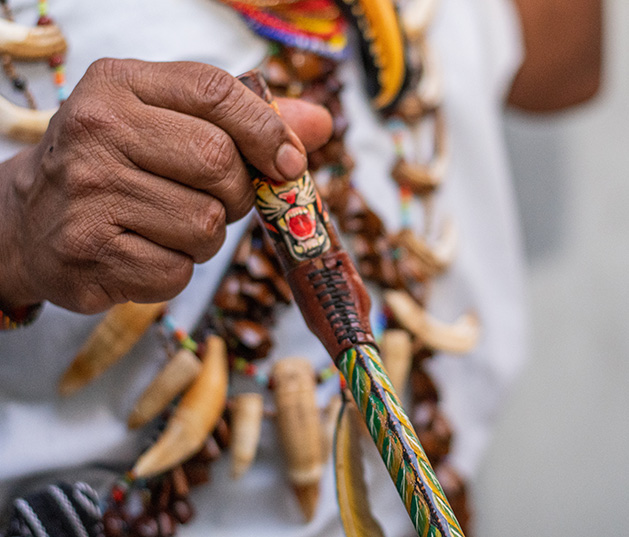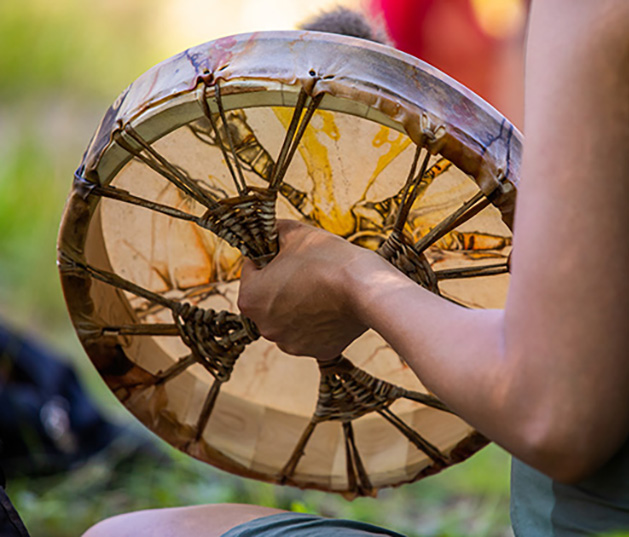
Shamanism and Shamanic Healing
Shamanism, a practice dating back thousands of years, continues to captivate the modern world with its mystique, spirituality, and healing potential. Delving into the wealth of ancient wisdom and otherworldly realms, shamans possess unique abilities to connect with the spiritual plane and bring forth transformative knowledge.
If you’ve ever been intrigued by the enigmatic world of shamans, their rituals, and how their practices can benefit modern society, you’ve come to the right place.
WHO IS A SHAMAN?
A shaman is a specially trained individual who is believed to possess an innate ability to connect with the spiritual world, transcending ordinary reality to access valuable wisdom and guidance.
Often referred to as the “walker between worlds,” shamans can bridge the gap between the physical and spiritual realms, harnessing their gifts to help others overcome various challenges in life.
Shamans come from diverse cultural backgrounds and have been revered by their respective communities for millennia. While practices may differ across cultures, a common thread unites them all — the belief that everything in nature is interconnected and that shamans can tap into this intricate web of existence to promote healing and well-being.
KEY ASPECTS OF SHAMANISM
Shamanism is anchored in a set of beliefs and principles that emphasize the interconnectedness of all living beings, the presence of spirits in the natural world, and the potential for personal transformation through spiritual practice.
The Core Aspects of Shamanism Include
The Spirit World and Its Inhabitants
Those who practice shamanism uphold the belief in a spiritual realm that exists alongside our tangible reality. They connect with various spirits, including ancestors, animal guides, elemental presences, and other metaphysical beings, to attain wisdom, direction, and healing energies.
Trance States and Journeying
Employing different techniques such as rhythmic drumming, chanting, dancing, or ingesting entheogenic substances (e.g., Ayahuasca or Salvia divinorum), shamans experience altered states of consciousness. These trance-like experiences facilitate their voyages to the spirit realm, where they can gather essential information for healing or recovering disjointed soul fragments.
Healing Practices and Sacred Rituals
Renowned for their restorative abilities, shamans utilize a fusion of spiritual, energetic, and herbal techniques to address physical, emotional, and metaphysical imbalances. Their healing methods may include exorcising unwanted spiritual influences, energy clearing, or performing sacred ceremonies to restore harmony and well-being.
Nature’s Sanctity and the Belief in Animism
Shamanic customs often emphasize the deep interconnectedness of all living creatures and the reverence for nature. By embracing animism (the conviction that everything possesses a distinct spiritual essence), shamans can collaborate with nature spirits, elemental forces, and the environment itself as reservoirs of potency, wisdom, and recuperative energies.
Ceremonial Rites and Ritualistic Observances
Shamanic practices regularly involve rituals and ceremonies designed for specific intentions like healing treatments/initiations or establishing connections with divine entities. These observances often involve the use of sound, specific dances, and offerings as means to invoke or pay homage to relevant spirits.
Divination Techniques for Guidance
As shamans are in close contact with the spiritual realm, they may utilize divination tools like bones, shells, or special cards to provide guidance for themselves or others. These practices can help reveal important messages from the spirits, help interpret one’s dreams, or offer clarity during difficult decision-making moments.
As mentioned above, the practice of shamanism is incredibly widespread, with hundreds of different cultures employing their own unique customs and beliefs. To gain the most from this fascinating practice, it’s best to seek guidance from experienced practitioners and study reputable sources.

Shamanic healing
Shamanic healing is a collection of holistic modalities that focus on addressing the root cause of physical, emotional, and spiritual imbalances. Drawing on their knowledge of the interconnectedness of all things and their ability to communicate with the spirit world, shamans can facilitate profound personal transformation and well-being.
Although the individual shamanic healing practices vary significantly based on their culture of origin, many similarities can be observed. Among the most common approaches to shamanic healing are:
Soul retrieval: This practice involves the shaman visiting the spirit world to locate and recover lost fragments of a person’s soul, which may have become separated due to trauma or other life challenges.
Extraction healing: Shamans are often skilled in identifying and removing unwanted energies or intrusions from a person’s energy field. This can help to restore balance, vitality, and overall well-being.
Power animal retrieval: In shamanic traditions, power animals are seen as spiritual allies that offer protection, guidance, and strength. A shaman can help an individual connect with their power animal by journeying to the spirit world on their behalf.
Ancestral healing: By connecting with the spirits of one’s ancestors, shamans can facilitate the healing of generational traumas and patterns that may be affecting a person’s life today.
Plant spirit healing: Many shamans work closely with plants to access their wisdom and healing properties. This can involve ingesting herbal remedies or engaging in rituals that honor the spirit of the plant.

shamanic journeying
Shamanic journeying is a practice that enables shamans and practitioners to access the spiritual realm consciously. By entering altered states of consciousness, they can gather information, guidance, and healing energies from the spirit world.
We can distinguish three primary realms in shamanic cosmology:
The Lower World is the realm of ancestors, power animals, and elemental energies. It represents the interconnection between all natural things and the wisdom of the natural world. This is where soul retrieval and power animal retrieval journeys take place. The Lower World is often associated with the subconscious mind, deep emotions, and primal instincts.
The Middle World represents the Earth plane and everyday reality. In this realm, shamans may communicate with nature spirits, such as plants, animals, and the elements. They can also receive guidance on physical matters and address issues related to this plane of existence.
The Upper World is the domain of higher spiritual entities, divine beings, and enlightened guides. It is the most abstract of the three realms – it may consist of cosmic energy patterns, fractals, prisms, or other celestial imagery. Journeying to the Upper World can help the shaman receive wisdom from the spirit teachers, helping them attain harmony and a greater understanding of universal truths.
A shamanic journey is a deeply individual experience – each person’s encounters with the spirit world will be unique to them. While some may see vivid images and landscapes, others might sense impressions or receive messages through their intuitive faculties.
Regardless of the form it takes, the shamanic journey allows for a profound connection with the spiritual realm, which may lead to personal growth, insight, and healing.

shamanic dreaming
To a shaman, dreams aren’t simply a byproduct of the subconscious. Dreams hold great importance in shamanic traditions, as they are seen as a direct link to the spirit world and a powerful source of knowledge and wisdom.
Shamanic dreaming is a practice that involves the exploration and interpretation of one’s dreams to gain insight, guidance, and healing. In shamanism, dreams can serve several purposes, from communing with the spirits to healing past traumas to even receiving prophetic messages about the future.
To benefit from shamanic dreaming, one must cultivate a strong connection with their dreams by practicing relaxation to enhance dream recall and keeping a dream journal to document experiences.
It’s also important to engage in dream incubation – a practice of setting clear intentions before sleep. Hyper-focusing on a specific question or problem while still awake can increase the chances of receiving meaningful information in a dream.
Once you’ve established a regular dreaming practice, you can begin to explore the different techniques for interpreting your dreams. However, bear in mind that making sense of dreams is a highly intricate process requiring a good understanding of symbolism, metaphors, and archetypes. Therefore, it’s always best to seek help from an experienced shaman or dream expert to get the most accurate insights.
Shamanism and the Digital Age
Despite being often associated with the traditional and ancient world, shamanism continues to thrive and adapt to the realities of the digital age. Modern technology has made shamanic knowledge and practices more accessible than ever before.
Online courses, workshops, and seminars allow individuals from all over the world to learn about and engage with shamanic practices. The Internet offers a wealth of resources for those seeking guidance on their spiritual journey, including instructional videos, articles, forums, and even live sessions with experienced shamans.
Social media platforms have also played a significant role in connecting like-minded individuals who share an interest in shamanism, fostering a global community of practitioners and enthusiasts.
Moreover, innovative digital tools have emerged to facilitate shamanic practices in new ways. For example, mobile apps may offer guided shamanic journeys and meditation practices, while virtual reality experiences can simulate immersive environments for spiritual exploration.
As the digital revolution continues to shape our lives, shamanism has demonstrated its resilience and adaptability, evolving to meet the spiritual needs of an increasingly interconnected world. By embracing these technological advancements, contemporary shamans and practitioners can further expand their reach and impact, providing healing and wellness to those seeking solace in a rapidly changing world.
